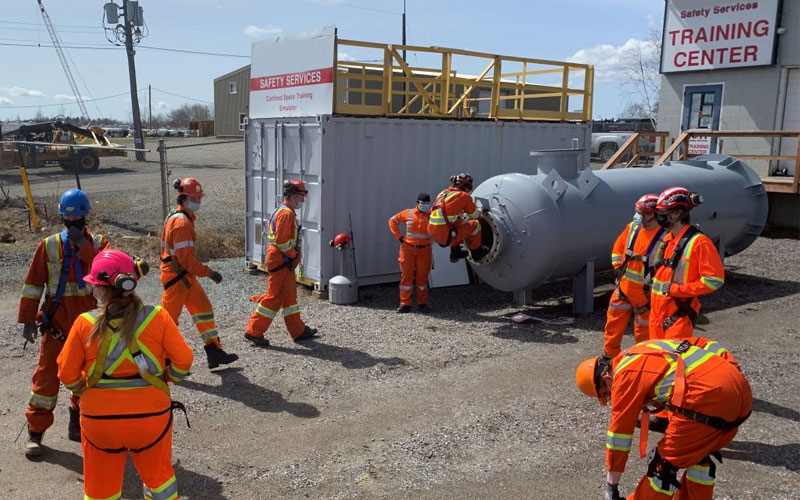Working in tight places poses unique challenges and risks. To ensure safety during entry and operations, specialist training is required. Storage tanks, sewers, and small enclosed rooms are not designed for continuous occupancy. These areas can be found in a variety of industries. Construction, manufacturing, petrochemicals, and utilities are all included.
Safety comes first when traveling through limited places to avoid accidents, injuries, and loss of life. Extensive training and teaching on safe operations in these situations are critical to meeting this goal.
Understanding Confined Spaces
Confined spaces encompass diverse environments, ranging from storage tanks and sewers to tunnels, silos, and small, enclosed rooms. Despite their varying forms and functions, these spaces share several key characteristics, each of which significantly contributes to the need for specialized training and safety protocols.
Limited Access and Egress
One defining attribute of confined spaces is the limited access and egress points. These spaces are designed with a primary function in mind, be it storage, transportation, or any other specialized purpose. As a result, the entry and exit points are often restricted in size and scope.
This limitation poses a challenge when it comes to evacuating individuals in case of an emergency. Training plays a pivotal role in educating workers about the potential difficulties associated with limited access and egress and how to navigate them safely.
Restricted Airflow
Confined spaces are characterized by restricted airflow. The enclosed nature of these spaces often leads to poor ventilation, which can result in the accumulation of hazardous gases or the depletion of oxygen. Such conditions pose a grave threat to anyone entering these spaces.
Recognizing the limitations of airflow within confined spaces is an essential aspect of training. Workers are taught how to detect and respond to atmospheric hazards, including the use of gas detectors and oxygen meters, to maintain a safe environment.
Potential Hazards
These spaces are rife with potential hazards. From toxic gases and hazardous materials to the lack of oxygen, confined spaces can present life-threatening dangers to those who enter them without adequate preparation. Understanding these potential risks is fundamental to ensuring the safety of workers.
Specialized training equips individuals with the knowledge and skills needed to identify these hazards, assess their severity, and take appropriate measures to mitigate them. This proactive approach is a linchpin of confined space safety, as it empowers workers to make informed decisions that protect their well-being.
The Importance of Proper Training
Specialized training is crucial for anyone who might have to enter or work in these environments. This training gives individuals the skills and knowledge to recognize potential dangers. Also, use safety equipment effectively and respond promptly and appropriately during emergencies.
Training confined spaces course on navigating confined spaces typically cover the following key aspects:
1. Hazard Identification and Assessment
The cornerstone of confined space safety lies in a thorough understanding of potential hazards. This encompasses a meticulous examination of atmospheric perils, encompassing the detection of oxygen deficiency and the presence of toxic gases.
Furthermore, it extends to recognizing a spectrum of physical hazards, from the risk of engulfment and entrapment to potential mechanical perils. The crux of training centers on acknowledging these hazards and imparting the skills to effectively assess and mitigate them before entry, ensuring a comprehensive approach to safety.
2. Proper Equipment Usage
Within the confines of these challenging spaces, the correct utilization of personal protective equipment (PPE) and specialized tools is paramount to ensure the safety of individuals. In these educational sessions, participants understand how to effectively employ essential equipment, such as harnesses, respirators, gas detectors, and communication devices.
The emphasis goes beyond mere usage, emphasizing meticulous care and regular maintenance of this equipment, guaranteeing it functions at the optimal level. This is crucial to maintain a high standard of safety and security.
3. Entry and Exit Procedures
Vital to averting accidents during confined space operations, the correct entry and exit procedures form a foundational training component. Participants are equipped with in-depth guidance on navigating these crucial steps safely.
This includes a thorough understanding of the significance of acquiring a permit and diligently adhering to established protocols. Additionally, it encompasses factors like the implementation of proper ventilation, the secure anchoring of points, and the utilization of communication systems to foster an environment of uncompromised safety.
4. Emergency Response and Rescue
A robust component of confined space training is preparedness for the unexpected. This readiness extends to a wide array of potential emergencies that may unfold within the confines of these spaces. First aid Training and cpr certificate empower individuals with the knowledge and skills to respond effectively in high-pressure situations.
This encompasses a deep dive into rescue techniques and the application of first aid within confined spaces. These competencies collectively ensure that a timely and efficient response is facilitated in the event of an accident, emphasizing the paramount importance of safeguarding lives.
5. Communication and Coordination
Effective communication and seamless coordination among team members are the bedrock of a secure working environment within confined spaces. Training places a strong emphasis on establishing crystal-clear lines of communication among participants. It further delves into the intricacies of understanding each team member’s distinct roles and responsibilities.
Through teamwork, participants are instilled with the ability to enhance safety significantly, promoting an environment where every voice is heard and each individual’s actions contribute to a collective commitment to safety and security. This comprehensive approach to training fosters a well-coordinated and safer working environment within confined spaces.
Prioritizing Safe Navigation of Confined Spaces
Ensuring the safe movement of workers through confined spaces is a top concern for industries facing such challenging conditions. Investing in crucial training programs for safe navigation is an investment in everyone’s safety and health, promoting a culture that values and prioritizes safety within the workplace.











